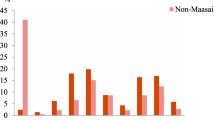Abstract
Aim
To determine the prevalence of oral malodour in Indian children and also to assess the relationship of oral malodour with oral hygiene, gingival health, dental caries, tongue coating, mouth breathing and frequency of tooth brushing.
Method
A total number of 900 school children (7–15 years) were included in the study. Children were assessed for the oral malodour, oral hygiene, gingival health, dental caries, tongue coating, mouth breathing and frequency of tooth brushing.
Results
The prevalence of oral malodour in Davangere school children was found to be 40.9 %. Oral malodour was significantly (p < 0.001) associated with age, mouth breathing, tongue coating, oral hygiene status, gingival status and tooth brushing frequency. Oral malodour was not significantly correlated with gender and caries status.
Conclusions
The prevalence of malodour in the population studied was 40.9 % and oral health status and oral malodour were associated with one another. The prevalence of oral malodour was considerably high and should not be neglected in children.
Similar content being viewed by others
References
Almas K, Al-Hawish A, Al-Khamis W. Oral hygiene practices, smoking habits, and self-perceived oral malodour among dental students. J Contemp Dent Pract. 2003;4(4):077–90.
Amir E, Shimonov R, Rosenberg M. Halitosis in children. J Pediatrics. 1999;134:338–43.
Cugati N. Oral malodour in children. J Dentofac Sci. 2012;1(2):17–19. http://www.journalofdentofacialsciences.com.
Donaldson AC, Riggio MP, Rolph HJ, Bagg J, Hodge PJ. Clinical examination of subjects with halitosis. Oral Dis. 2007;13:63–70.
Gholami PF, Minah GE, Turng BF. Oral malodour in children and volatile sulfur compound-producing bacteria in saliva: preliminary microbiological investigation. Pediatric Dent. 1999;21(6):320–4.
Greene JC, Vermillion JK. The simplified oral hygiene index. J Am Dent Assoc. 1964;68:7–13.
Greenman J. Study on the organoleptic intensity scale for measuring oral malodour. J Dent Res. 2004;83(1):81–5.
Greenman J, El-Maaytah M, Duffield J, et al. Assessing the relationship between concentrations of malodour compounds and odor scores from judges. J Am Dent Assoc. 2005;136:749–54.
Kanehira T, Takehara J, Takashi D, Honda O, Morita M. Prevalence of oral malodour and the relationship with habitual mouth breathing in children. J Clin Pediatr Dent. 2004;28(4):285–8.
Kara C, Tezel A, Orbak R. Effect of oral hygiene instruction and scaling on oral malodour in a population of Turkish children with gingival inflammation. Int J Pediatr Dent. 2006;16:399–404.
Klein R, Palmer C, Knutson JW, et al. Studies on dental caries 1. Dental status and dental needs of elementary school children, vol 53. Washington: Public Health Report; 1938. p. 751–65.
Kleinberg I, Westbay G. Oral malodour. Crit Rev Oral Biol Med. 1990;1:247–60.
Kleinberg I, Wolff MS, Codipilly DM. Role of saliva in oral dryness, oral feel and oral malodour. Int Dent J. 2002;52:236–40.
Linde J, Karring T, Lang NP. Clinical periodontology and implant dentistry, 5th edn, vol. 2. Oxford: Blackwell Publishing Company; 2008.
Liu XN, Shinada K, Chen XC, et al. Oral malodour-related parameters in the Chinese general population. J Clin Periodontol. 2006;33:31–6.
Loe H, Silness J. Periodontal disease in pregnancy. I. Prevalence and severity. Acta Odontol Scand. 1963;21:533–51.
Miyazaki H, Sakao S, Katoh Y, Takehara T. Correlation between volatile sulphur compounds and certain oral health measurements in the general population. J Periodontol. 1995;66(8):679–84.
Miyazaki H, Ariao M, Okamura K, et al. Tentative classification of halitosis and its treatment needs. Niigata Dent J. 1999;32:7–11.
Murata T, Yamaga T, Lida T, Miyazaki H, Yaegaki K. Classification and examination of halitosis. Int Dent J. 2002;52:181–6.
Nalcaci R, Dulgergil T, Oba AA, Gelgor IE. Prevalence of breath malodour in 7–11 year old children living in middle Anatolia, Turkey. Community Dent Health. 2008;25:173–7.
Quirynen M, Avontroodt P, Soers C, et al. The efficacy of amine fluoride/stannous fluoride in the suppression of morning breath odour. J Clin Periodontol. 2002;29:944–54.
Rosenberg M, Kulkarni GV, Bosy A, McCulloch CAG. Reproducibility and sensitivity of oral malodor measurements with a portable sulfide monitor. J Dent Res. 1991;11:1436–40.
Sanz M, Roldán S, Herrera D. Fundamentals of breath malodour. J Contemp Dent Pract. 2001;2(4):1. http://www.thejcdp.com/issue008/sanz/01sanz.htm.
Tonzetich J, Ng SK. Reduction of malodour by oral cleansing procedures. Oral Surg Oral Med Oral Pathol. 1976;42(2):172–81.
Tonzetich J. Oral malodour: an indicator of health status and oral cleanliness. Int Dent J. 1978;28:309–19.
Touyz LZ. Oral malodour—a review. J Can Dent Assoc. 1993;59:607–10.
Van Steenberghe D, Quirynen M. Breath malodour. In: Lindhe J, Karing T, Lang NP, (eds). Clinical periodontology and implant dentistry. Oxford: Blackwell Munksgaard; 2003. p. 512–8.
Yaegaki K, Sanada K. Volatile sulfur compounds in mouth air from clinically healthy subjects and patients with periodontal disease. J Periodontal Res. 1992a;27(4 Pt 1):233–8.
Yaegaki K, Sanada K. Biochemical and clinical factors influencing oral malodour in periodontal patients. J Periodontol. 1992b;63(9):783–9.
Author information
Authors and Affiliations
Corresponding author
Rights and permissions
About this article
Cite this article
Patil, P.S., Pujar, P., Poornima, S. et al. Prevalence of oral malodour and its relationship with oral parameters in Indian children aged 7–15 years. Eur Arch Paediatr Dent 15, 251–258 (2014). https://doi.org/10.1007/s40368-014-0109-0
Received:
Accepted:
Published:
Issue Date:
DOI: https://doi.org/10.1007/s40368-014-0109-0




